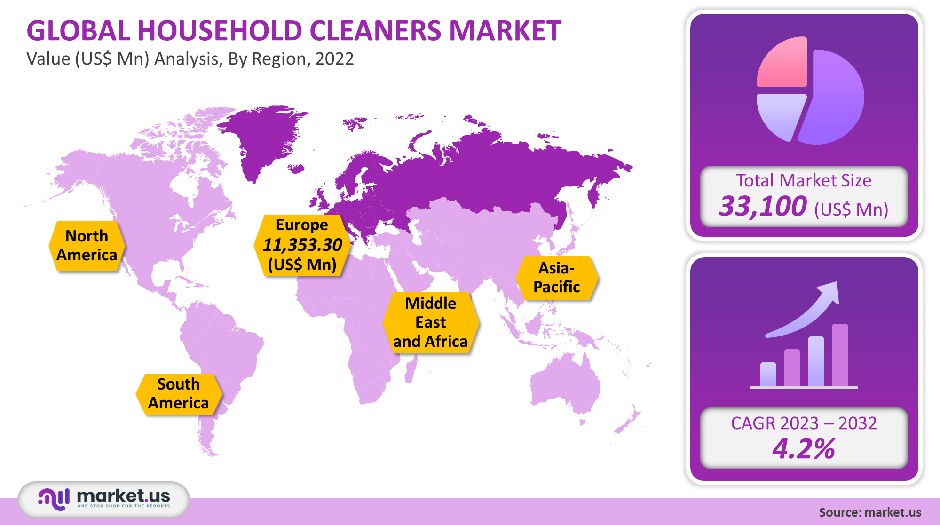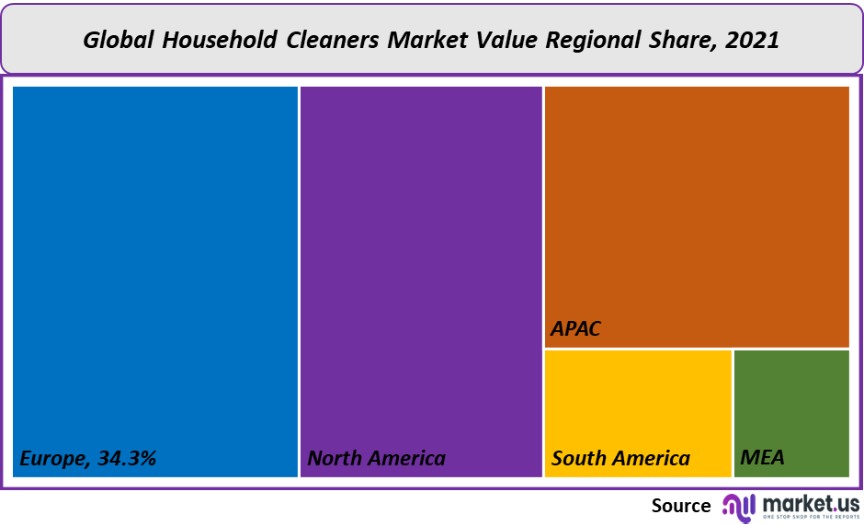Global Household Cleaners Market By Ingredients (Chemical and Natural), By Product (Surface Cleaner, Toilet Bowl Cleaner, Glass Cleaner, and Others), By Distribution Channel (Online and Offline), By Region and Companies - Industry Segment Outlook, Market Assessment, Competition Scenario, Trends and Forecast 2022-2032
- Published date: May 2023
- Report ID: 36738
- Number of Pages: 294
- Format:
- keyboard_arrow_up
Quick Navigation
Household Cleaners Market Overview:
The global household cleaners market is estimated to reach USD 33,100 million in 2021. This number will increase at a compound annual growth rate of 4.2% between 2023-2032.
This is due to the growing awareness of hygiene among consumers. The demand for household cleaners will also increase due to the constant advancements in this sector. Poor hygiene can lead to many health issues, such as Buruli ulcers, diarrhea, and other problems. It is important that consumers practice proper hygiene.
Global Household Cleaners Market
Ingredients Analysis
With over 86% share of the global market revenue, the chemical ingredients sector accounted for the largest portion of 2021’s total. Chemicals are commonly used in household cleaners such as solvents, bleaches, and surfactants. Recent years have seen a substantial increase in the demand for chemical cleaning products. Due to the COVID-19 epidemic, customers are increasingly using chemical-based household cleansers as a way to disinfect their homes.
The rising threat of the COVID-19 epidemic has seen chemical cleaning product usage and sales increase at an unprecedented level. However, the growing concern about side effects from chemical-based household cleaners may limit their growth over the forecast period.
However, the segment of natural ingredients is projected to see the greatest growth rate in the forecast period. Due to growing demand, the segment is projected to increase at a 7.2% CAGR over 2023-2032. The natural-based ingredients segment will see significant growth due to rising awareness and importance among consumers of sustainable and environmentally-friendly cleaning products in the future.
These solutions are also made with natural substances, such as vinegar, natural sugar, oils, baking soda, and other natural ingredients. This helps to prevent dangerous chemicals from getting mixed in the open. They are skin-friendly and have been used in many different applications.

Distribution Channel Analysis
In 2021, the market share for offline distribution channels was 83%. The offline segment comprises specialty stores, hypermarkets supermarkets, independent retail shops, and others. In emerging economies like India, China, and Malaysia, the organized retail sector is expected to increase household cleaning product demand in the next few years. All these factors are expected to drive growth in this market during the forecast period.
Because of the increasing use and popularity of the internet, the fastest growth will be seen in the online segment during the projection period. In the next few years, the online distribution channel is expected to grow due to an increase in sales of household cleaners, mainly through eCommerce portals and company websites.
The popularity of online platforms like Google ads and social media has influenced consumer preferences for buying household cleaning products through eCommerce platforms such as Amazon, Flipkart, and Walmart. The increase in smartphone and high-speed internet usage is forecast to drive the growth of the online channel.
Product Analysis
Because of its growing demand, the top-selling product category in household cleaners was the surface cleaner segment. It accounted for more than 55% of the total global household cleaners market revenues in 2021. Surface cleaners can be used to clean up stains, dust, and other clutter. A variety of surface cleaners are available for different surfaces, such as tiles and wood. The forecast period will also see a rise in demand for surface cleaners.
Global demand for surface cleaners has increased due to rising risks of infection and bacterial infections spread by polluted floors. In order to meet the significant increase in surface cleaners customer demand, manufacturers are constantly developing new products and technical breakthroughs.
Prognosticators predict that the toilet bowl cleaner segment will be the fastest-growing segment. It is expected to see significant growth during the forecast period. Due to the growing demand for cleaner toilets in households around the globe, the segment is projected to grow by 5.4% from 2023-2032. In response to increasing public awareness regarding sanitary hygiene, the segment has expanded.
Many people are concerned about their health and how they use the bathroom due to contagious illnesses. Increased spending on toilet care products has been a result of rising consumer awareness about the importance of a healthier lifestyle and cleaner environment.
Due to the increasing use of glass in furnished and semi-furnished houses, the glass cleaner segment accounted for a significant share of the market in 2021. Glass cleaners are growing in popularity in both commercial and residential applications. Glass plays a key role in furniture and decoration.
Key Market Segments
Ingredients
- Chemical
- Natural
Product
- Surface Cleaner
- Toilet Bowl Cleaner
- Glass Cleaner
- Others
Distribution Channel
- Online
- Offline
Market Dynamics
The household cleaner market has seen a significant increase in awareness about keeping their home clean. Market growth will also be driven by the ease of access to household cleaners in a variety of fragrances. In the coming years, this market will be driven by changing lifestyles and rapid urbanization.
A dramatic increase in household cleaning items worldwide has been caused by rising consumer concerns regarding cleanliness and health. The future will see a rise in household cleaning products due to rising disposable income and rapid urbanization. The market is set to grow significantly in the future due to increased demand for environmentally friendly, sustainable household cleaning products.
The future of household cleaning product sales is expected to be boosted by innovative packaging, brand design, and promotion. The demand for eco-friendly cleaning products has grown due to growing consumer concerns about their health and the environment. Organic products are expected to see strong growth because they don’t contain hazardous chemicals and have a pleasant odor.
Industry sales are projected to rise due to increased investments by key players in the development of eco-friendly products. However, household cleaners containing chemicals that can be toxic to the skin and can cause allergic reactions and skin irritations could limit the market growth.
Due to the COVID-19 pandemic the household cleaners market has experienced a significant increase in demand. This presents numerous opportunities for market players. During the pandemic, the market is experiencing a surge in awareness due to the spreading of the COVID-19 viruses.
In recent years, the market has seen an increase in the frequency and importance of the COVID-19 epidemic as well as increased focus on hygiene among people. The growing demand for eco-friendly cleaning products will offer industry leaders promising opportunities.
There has been an increase in chemical-free cleaning products. Key companies are now launching new scents like natural deodorizers and citrus. Fresheners are also a crucial part of market buying decisions. Market leaders are also optimizing the use of online platforms to sell their items and list them on major social media platforms. This allows them to reach more consumers and increase market exposure.
The global market is dominated by environmental concerns and the consequent drive for sustainable products. Most consumers are more environmentally friendly if they prefer recycled and recyclable packaging. They also favor low-temperature products and non-harmful, chemical-free items. Globally, there will be a significant shift in consumer preference towards chemical-free parts.
Regional Analysis
Europe contributed the most to the global marketplace in 2021 with a 34.3% share. Majorly, this market’s growth is due to the rising sales of environmentally-friendly and sustainable household cleaners. The market will also see an increase in demand for toilet cleaners and surface cleaners during the forecast period.
An increase in household cleanser sales has been due to consumer awareness about hazardous diseases that can be transmitted through unclean surfaces. Additionally, cleaners with pleasant and natural scents are increasingly in demand. In response to increasing market demand, governments in several countries are implementing diverse initiatives.
Asia Pacific is predicted to experience the highest CAGR, 5.8%, between 2023-2032. This can be attributed largely to the rising demand for household cleaning products within the region. There has also been a lot of demand in the region for eco-friendly surface cleaners. These are all likely to drive the market’s growth during the projected period.
Due to increasing emphasis on hygiene and cleanliness, domestic and international manufacturers are constantly releasing new products to meet the demand from countries like India and Japan. In this area, product sales will be boosted by government initiatives like Swachh Bharat Abhiyan (India), among others.

Key Regions and Countries covered іn thе rероrt:
- North America
- US
- Canada
- Mexico
- Europe
- Germany
- UK
- France
- Italy
- Russia
- Spain
- Rest of Europe
- APAC
- China
- Japan
- South Korea
- India
- Rest of Asia-Pacific
- South America
- Brazil
- Argentina
- Rest of South America
- MEA
- GCC
- South Africa
- Israel
- Rest of MEA
The key players in the market are focusing their R&D efforts and are also creating new sustainable and environmentally-friendly products to satisfy the increasing demand. In addition to expanding the market, they invest in innovative manufacturing of natural-based cleaners. They also have major business plans, including mergers and acquisitions as well as celebrity endorsements and expansion of distribution channels.
Reckitt Benckiser Group Plc introduced a germ-busting kitchen product in August 2018 called “Lizol Kitchen”, in a campaign featuring Vikas Khanna. Khanna is a well-known Indian chef. Procter & Gamble’s (P&G), Microban 24 Hour, a home sanitizing product that kills bacteria, was also launched in February 2020.
These initiatives are expected to open new opportunities for the products in the near term. Manufacturers are expected to focus on improving technology to address the needs of emerging countries and untapped markets in order to achieve maximum market share.

Key Market Players
These are the major companies that operate in the global household cleaners industry:
- Colgate-Palmolive Company
- Unilever
- Henkel AG & Co. KGaA
- Clorox Company
- Procter & Gamble
- Kao Corporation
- Reckitt Benckiser Group PLC
- Godrej Consumer Products
- Other Key Players
For the Household Cleaners Market research study, the following years have been considered to estimate the market size:
Attribute Report Details Historical Years
2016-2020
Base Year
2021
Estimated Year
2022
Short Term Projection Year
2028
Projected Year
2023
Long Term Projection Year
2032
Report Coverage
Competitive Landscape, Revenue analysis, Company Share Analysis, Manufacturers Analysis, Volume by Manufacturers, Key Segments, Key company analysis, Market Trends, Distribution Channel, Market Dynamics, COVID-19 Impact Analysis, strategy for existing players to grab maximum market share, and more.
Regional Scope
North America, Europe, Asia-Pacific, South America, Middle East & Africa
Country Scope
United States, Canada and Mexico, Germany, France, UK, Russia and Italy, China, Japan, Korea, India and Southeast Asia, Brazil, Argentina, Colombia etc.Saudi Arabia, UAE, Egypt, Nigeria and South Africa
Frequently Asked Questions (FAQ)
Q: What is the size of the Household Cleaners market in 2021?A: The Household Cleaners market size was US$ 33,100 million in 2021.
Q: What is the projected CAGR at which the Household Cleaners market is expected to grow at?A: The Household Cleaners market is expected to grow at a CAGR of 4.2% (2023-2032).
Q: List the segments encompassed in this report on the Household Cleaners market?A: Market.US has segmented the Household Cleaners market by geographic (North America, Europe, APAC, South America, and Middle East and Africa). By Ingredients, market has been segmented into Chemical and Natural. By Product, the market has been further divided into Surface Cleaner, Toilet Bowl Cleaner, Glass Cleaner, and Others. By Distribution Channel, market has been segmented into Online and Offline.
Q: List the key industry players of the Household Cleaners market?A: Colgate-Palmolive Company, Unilever, Henkel AG & Co. KGaA, Clorox Company, Procter & Gamble, Kao Corporation, Reckitt Benckiser Group PLC, and Other Key Players engaged in the Household Cleaners market.
Q: Which region is more appealing for vendors employed in the Household Cleaners market?A: Europe is accounted for the highest revenue share of 34.3%. Therefore, the Household Cleaners industry in Europe is expected to garner significant business opportunities over the forecast period.
Q: Name the key areas of business for Household Cleaners?A: The U.S., Germany, U.K., France, China, India, South Africa, and Brazil are key areas of operation for Household Cleaners Market.
Q: Which segment accounts for the greatest market share in the Household Cleaners industry?A: With respect to the Household Cleaners industry, vendors can expect to leverage greater prospective business opportunities through the chemical ingredients segment, as this area of interest accounts for the largest market share.

- Colgate-Palmolive Company
- Unilever Plc Company Profile
- Henkel AG & Co. KGaA
- Clorox Company
- Procter & Gamble
- Kao Corporation Company Profile
- Reckitt Benckiser Group PLC Company Profile
- Godrej Consumer Products
- Other Key Players
- settingsSettings
Our Clients
| Single User $4,599 $3,499 USD / per unit save 24% | Multi User $5,999 $4,299 USD / per unit save 28% | Corporate User $7,299 $4,999 USD / per unit save 32% | |
|---|---|---|---|
| e-Access | |||
| Report Library Access | |||
| Data Set (Excel) | |||
| Company Profile Library Access | |||
| Interactive Dashboard | |||
| Free Custumization | No | up to 10 hrs work | up to 30 hrs work |
| Accessibility | 1 User | 2-5 User | Unlimited |
| Analyst Support | up to 20 hrs | up to 40 hrs | up to 50 hrs |
| Benefit | Up to 20% off on next purchase | Up to 25% off on next purchase | Up to 30% off on next purchase |
| Buy Now ($ 3,499) | Buy Now ($ 4,299) | Buy Now ($ 4,999) |











